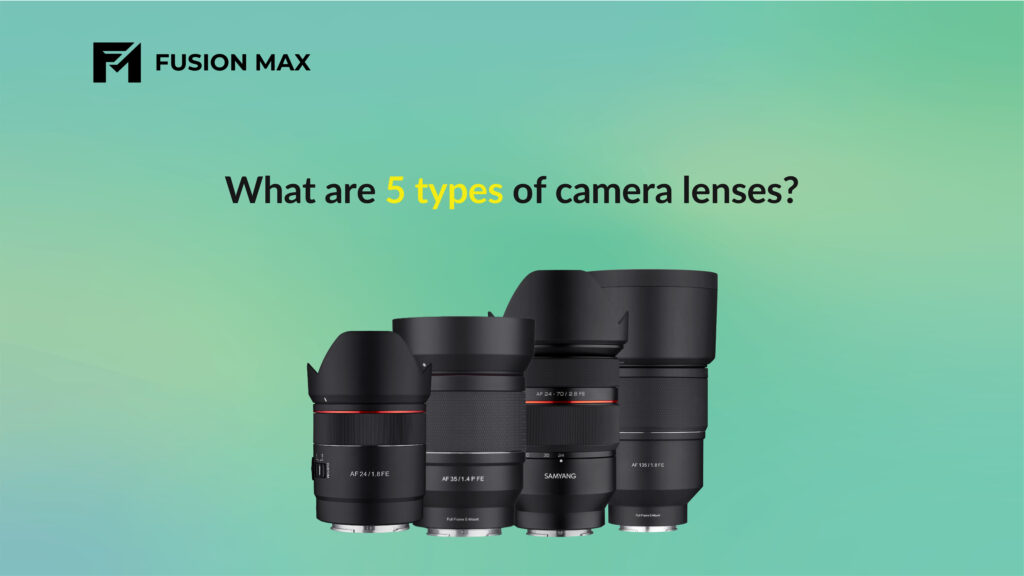In photography and video shooting, the camera lens serves an important role in determining the quality and style of your shots. Indeed, the lenses of each type are used in particular ways, and they provide distinct functions that allow photographers to create various effects. No matter whether you want to shoot a landscape or portraits, or fleeting movement, the right lens can do wonders. Moreover, the correct equipment will enable you to produce sharp, well-detailed photos with the perfect depth of field and point of view. Knowledge of various photographic lenses will help you in choosing the specific lens that can fit your requirements. For example, from prime lenses that offer sharpness and clarity to zoom lenses that provide versatility, each type has its advantages.
In this article, we will discuss the five different types of camera lenses. Their features and assist you in making better choices on the specific camera lens to use when undertaking a photography or videography project.
Why Choosing the Right Camera Lens Matters
To make the most out of the shots, it is important to select the correct camera lens. If you are an amateur or a professional in the field, the choice of the lens you want to use determines the clarity of the image, the depth of field, and the point of view. A camera’s optics is not all about distance, which you can zoom. But it is concerned with the impact it has on your images or video shoots. Use of the incorrect lens may provide a blurred picture, wrong lighting or unwanted distortions.
Therefore, having the suitable lens guarantees that you will receive the best from your camera devices and be able to create high-quality content that is going to stand out. For instance, a prime lens can provide better sharpness when it comes to portraiture, whereas a telephoto lens is the best lens type when photographing sports and wildlife.
Types of Camera Lenses Explained
Camera lenses are available in various sizes and shapes, which have multiple functions that they perform. Now, let’s take a look at the multiple types of lenses and what they can offer:
What is a Prime Lens? – Sharp and Lightweight for Professionals
A prime lens is any camera lens with a fixed focal length, which does not zoom. This would suit photographers, who are inclined to sharpness, clarity and simplicity. The prime lenses tend to be lighter and smaller in size compared to zoom lenses, and they are easily portable. Additionally, they have large apertures and more light can enter the camera, which is useful in low-light scenarios. Due to this they become quite popular with professional photographers, particularly portrait, street, and fine art photographers.
Ideal Use Case
- Portrait photography
- Street photography
- Low-light situations
- Landscape photography
Example: Samyang AF 35mm F1.4 P FE – Known for its incredible sharpness and smooth bokeh, the Samyang 35mm F1.4 is a top choice for professional portrait photographers.
What is a Zoom Lens? – Versatile for All Types of Shots
A zoom lens is flexible since you can adjust the focal length, which implies using the zoom effect without having to change lenses. This flexibility then counts as a good selection for photographers who have to change between wide-angle shots and close-ups, in which they cannot afford to miss a single moment. Zoom lenses are often used in travel, event and wedding photography as they enable you to change your composition without having to physically change location. They may not be as sharp as prime lenses, but in modern zoom lenses, quality images are still captured, and in most cases, are convenient.
Ideal Use Case
- Travel photography
- Wedding photography
- Sports photography
- Wildlife photography
Example: Samyang AF 24-70mm F2.8 – With its wide focal length range, this zoom lens is perfect for capturing both expansive landscapes and close-up details.
What is Wide Angle Lens Photography? – Capture More in One Frame
A wide-angle lens enables you to shoot more of the scene within an individual shot, and thus it is ideal when shooting wide landscapes, architecture, and interiors. The focal length of these lenses is usually short, at about 14mm to 35mm at most, and these lenses can capture more of the scene. They are particularly popular in landscape photography, where the objective is to depict huge landscapes in the environment or in urban areas. The dramatic effect of depth and space is created with the wide-angle lenses, which is why these lens types are also favorites in narrative filmmaking.
Ideal Use Case
- Landscape photography
- Architecture and interiors
- Group shots
- Creative composition
Example: Samyang 14-24mm F2.8 FE– This wide-angle lens is perfect for capturing expansive landscapes and large architectural structures.
What is a Telephoto Lens? – Get Closer Without Moving
A telephoto lens enables you to take photos of a faraway object without necessarily making a physical closer position. Telephoto lenses have a long focus, usually 70mm and up, and enlarge distant objects. Therefore, they are ideal for wildlife, sports, or portrait photography. In addition, they help capture clear, sharp images of faraway subjects. As a result, detail and focus remain high. Thus, telephoto lenses are essential for photographers who need precision at a distance. Telephoto lenses also gives a shallow depth of field and are ideal for separating the subject and the background.
Ideal Use Case
- Wildlife photography
- Sports photography
- Portrait photography
- Events
Example: Samyang AF 135mm F1.8 FE – This telephoto lens is ideal for portrait photographers looking for stunning background blur and detail in their shots.
What is a Fisheye Lens? – For Creative and Distorted Perspectives
A fisheye lens is a kind of ultra-wide camera lens that produces a distinctive and distorted view. It also has a very wide view that normally ranges around 180 degrees and 220 degrees, rendering it excellent for developing interesting and surreal shots. Therefore, ultra-wide lenses take advantage in experimental photo-taking and artistic photography. They are capable of distorting the image by making it focus central, yet the edges will be curved, and this creates an impression of playfulness and creativity. This kind of lens is common in narrative filmmaking and used in high adventure picture photography.
Ideal Use Case
- Creative photography
- Extreme sports photography
- Experimental videography
- Artistic compositions
Example: Samyang 12mm F2.8 ED AS NCS FISHEYE – Known for its quality build and sharp images, this fisheye lens is great for those looking to experiment with unconventional perspectives.
Best Camera Lens for Video – What to Look For
There are a couple of things to keep in mind when choosing a camera lens to shoot video that can make a great deal of difference to the look of your footage.
Wide Aperture (Low f-number)
A camera lens that has a wide aperture (low f-number) makes it admits much light, which is important in low-light video shooting. It also supports a shallow depth of field, which is useful in obtaining the blurred cinematic backgrounds.
Fast and Quiet Autofocus
It is important to have a fast and silent autofocus camera lens for the production of videos. This ensures that the lens can focus on subjects quickly without producing distracting sounds, which is especially important during narrative filmmaking.
Focal Length That Matches Your Style
Your camera lens focal length will decide the degree of zoom in or out of your shot. When it comes to video, the focal length you select must be appropriate to the style you shoot in, do you’re shooting in wide-angle detail, or close-up shots and so on.
Best Lens Brand in Pakistan – Why Samyang Stands Out
Samyang is one of the top lens brands in Pakistan. Moreover, it offers lenses for both amateur and professional photographers. Notably, Samyang lenses are known for their strong build and affordable price. As a result, they deliver sharp images and reliable performance. Additionally, their range includes prime, zoom, and telephoto lenses. Whether you need a wide-angle or fisheye lens, Samyang maintains high quality. Therefore, it remains a preferred choice among photographers in Pakistan.
Where to Buy Camera Lenses in Pakistan?
- Lk Samyang official website – The fastest and safest place you can get original Samyang lenses in Pakistan.
- It provides direct access to the recent models with safe payment charges, the warranty of the product, and customer care.
- Fusion Max – An authorized dealer in Pakistan offering warranty, after-sales and technical support to customers who want quality lenses and related camera gear.
- Fusion Max Authorized Dealers Network – It has a network of Official Dealers all over Pakistan, so that customers can get quality-checked (genuine) Samyang lenses with the guarantee of warranty and professional service.
- Nisbat Road Camera Market Lahore – A bustling market in Lahore, well-known for offering a wide range of camera gear and accessories at competitive prices, with so many options in an area.
Final Thoughts
To conclude, choosing the proper camera lenses can make all the difference in achieving the best outputs of your photography or videography. Whether it is a prime lens to produce a more crisp and clear picture or a zoom lens to allow flexibility. Each type of lens has its own advantages in certain shooting styles and occasions. The focal length, the lens type, and the situations when the lens is effective at its best will allow you to make a conscious choice and improve your creative work. Looking to take still photography or filmmaking, the right camera lenses can be your savior.
FAQ’s
The best is the Samyang 12mm F2.8 ED AS NCS FISH-EYE. It provides a clear picture and a durable construction. What is more, the lens is unique and possesses a 180-degree field of vision. It is perfect in artistic photography, experimental video and extreme sport shots.
Of course, Samyang lenses are characterized by very good build quality and sharpness. Moreover, they are also cheap. The brand provides an affordable, wide range, including prime, zoom, wide-angle, and fisheye lenses. Samyang is the favorite of amateur and professional photographers in Pakistan.
A zoom lens adjusts focal length. This enables close-up to wide shots without swapping lenses. A macro lens takes extreme close-ups. It can focus on very small issues with high resolution, in some cases at the scale of life or larger.
A wide-angle lens has greater coverage and less distortion. Therefore, it is fantastic in landscapes and architecture. A fisheye lens has a very wide range and produces a high degree of image curvature. It has an artistic, distorted touch in experimental and creative photography.


